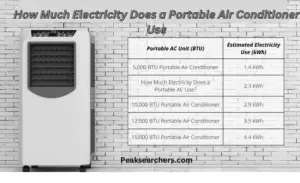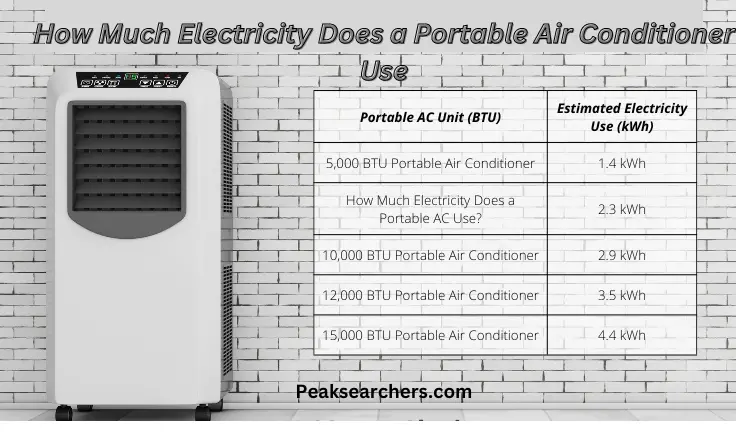How Much Electricity Does a Portable Air Conditioner Use? A Step By Step Guide
Welcome to our comprehensive guide on How Much Electricity a Portable Air Conditioner Use. As experts in the field, we understand the importance of finding efficient and cost-effective cooling solutions for your space. In this article, we will delve into the factors that influence the electricity usage of portable air conditioners, provide an in-depth analysis of their power consumption, and offer valuable tips to help you make informed decisions when purchasing and operating these units.

Understanding Power Consumption
Portable air conditioners are a popular choice for cooling individual rooms or small spaces. However, it’s crucial to assess their electricity usage to ensure they align with your energy requirements. The power consumption of a portable air conditioner can vary depending on several key factors, including:
- BTU Capacity: British Thermal Units (BTUs) measure the cooling capacity of an air conditioner. Higher BTU ratings generally indicate greater cooling power but may also result in increased energy consumption.
- Energy Efficiency Ratio (EER): The EER is a ratio that represents the cooling output of an air conditioner divided by the electrical input required to achieve that level of cooling. A higher EER signifies better energy efficiency and lower electricity usage.
- Operating Modes: Portable air conditioners often feature multiple operating modes, such as cooling, dehumidification, and fan-only mode. The power consumption can vary depending on the mode selected and the intensity of cooling desired.
- Temperature Settings: Lowering the set temperature on your portable air conditioner can significantly impact energy consumption. Maintaining moderate temperature settings helps optimize energy efficiency while still providing comfortable cooling.
Calculating Electricity Usage
To estimate the electricity consumption of a portable air conditioner, you need to consider the power rating and the duration of usage. The power rating is usually provided in watts (W) and can be found in the unit’s specifications or on the label.
Example Calculation
Let’s illustrate the calculation using a hypothetical scenario. Suppose you have a portable air conditioner with a power rating of 1,200 watts (1.2 kW) and you use it for 8 hours per day.
Energy Consumption = 1.2 kW × 8 hours / 1000 = 9.6 kWh per day
Tips for Optimizing Energy Efficiency
Now that we have explored the factors affecting the electricity usage of portable air conditioners, let’s discuss some practical tips to help you optimize energy efficiency:
- Choose an Appropriate BTU Capacity: Select a portable air conditioner with a BTU rating suitable for the size of the room you intend to cool. Oversized units may consume more electricity and result in excessive cooling, while undersized units might struggle to cool the space efficiently.
- Look for High EER Ratings: Energy-efficient models with higher EER ratings can significantly reduce electricity consumption without compromising cooling performance. Look for units with an EER of 10 or higher for optimal efficiency.
- Consider Programmable Timers: Portable air conditioners equipped with programmable timers allow you to schedule their operation according to your needs. By programming the unit to turn off when you’re not at home or during cooler periods of the day, you can minimize unnecessary energy consumption.
- Improve Insulation: Properly insulating your room can help retain the cool air generated by the portable air conditioner. Insulated windows, doors, and walls prevent the infiltration of warm air, reducing the workload on the air conditioner and ultimately lowering energy consumption.
- Regular Maintenance: Keep your portable air conditioner in excellent working condition by performing regular maintenance tasks such as cleaning or replacing filters, clearing obstructions around the unit, and ensuring proper airflow. Well-maintained units operate more efficiently and consume less electricity.
. Additional Energy-Saving Features
Some portable air conditioners come equipped with additional energy-saving features that can further optimize their electricity usage:
- Sleep Mode: This mode adjusts the cooling intensity and fan speed during nighttime operation, aiming for energy efficiency and a comfortable sleeping environment.
- Auto Mode: Auto mode automatically adjusts the cooling output and fan speed based on the room temperature, ensuring efficient operation while maintaining the desired comfort level.
- Smart Thermostats: Certain portable air conditioners integrate with smart thermostats, allowing you to control and schedule their operation remotely. This feature enables you to optimize energy usage by adjusting cooling settings according to your preferences and occupancy patterns.
Also Read: Do Portable Air Conditioners Use A Lot Of Electricity? A DIY Guide
FAQ’s
Do portable AC use more electricity?
Portable air conditioners typically consume more electricity compared to other cooling devices due to their higher power output, BTU capacity, and usage patterns.
While energy-efficient models are available, portable air conditioners, in general, have lower energy efficiency compared to central air conditioning systems or split air conditioners. Factors such as operating modes, room insulation, and maintenance also influence their electricity usage.
Despite their higher energy consumption, portable air conditioners offer convenience and flexibility for cooling specific areas or rooms where other cooling options may not be suitable.
Do portable air conditioners use more electricity than fans?
Yes, portable air conditioners typically use more electricity than fans. Fans operate by circulating air and providing a breeze, requiring much less energy compared to the cooling mechanisms of air conditioners.
Portable air conditioners, on the other hand, use compressors and refrigeration systems to remove heat and moisture from the air, resulting in higher electricity consumption.
While fans are energy-efficient options for providing airflow and a cooling sensation, portable air conditioners offer more powerful and effective cooling capabilities, albeit at a higher energy cost.
What is the most efficient way to run a portable air conditioner?
- Choose the Right BTU Capacity: Select a portable air conditioner with an appropriate BTU capacity for the size of the room you want to cool. An oversized unit will consume more energy without providing additional benefits, while an undersized unit may struggle to cool the space effectively.
- Optimize Temperature Settings: Set the temperature to a moderate and comfortable level. Lowering the temperature excessively will increase energy consumption. Consider using a programmable thermostat to automatically adjust the temperature based on your needs and occupancy patterns.
- Use Energy-Saving Modes: Take advantage of energy-saving modes available on your portable air conditioner. These modes, such as sleep mode or energy-saving mode, adjust the cooling intensity and fan speed to optimize energy usage while maintaining comfort.
- Proper Insulation: Improve the insulation of your room by sealing any gaps around windows, doors, and walls. Proper insulation helps prevent the escape of cool air and the infiltration of warm air, reducing the workload on the air conditioner.
- Manage Airflow: Ensure that the airflow around the portable air conditioner is not obstructed. Keep curtains, furniture, and other objects away from the unit to allow proper air circulation and efficient cooling.
- Use Timers: Utilize the timer function if your portable air conditioner has one. Set the timer to turn off the unit when you’re not in the room or during periods when cooling is not required. This helps save energy by avoiding unnecessary operations.
- Regular Maintenance: Keep your portable air conditioner in good working condition by performing regular maintenance. Clean or replace air filters as recommended by the manufacturer to ensure proper airflow and efficient operation. Additionally, clean the condenser coils and remove any dust or debris that can hinder performance.
Also Read: Can You Recharge A Portable Air Conditioner? A Comprehensive Guide
Conclusion
In conclusion, understanding the electricity usage of portable air conditioners is crucial for making informed decisions about cooling your space effectively while minimizing energy consumption.
By considering factors such as BTU capacity, EER ratings, and operating modes, you can select a unit that suits your needs while optimizing energy efficiency. Remember to calculate the energy consumption using the provided formula and implement energy-saving practices like programmable timers and proper insulation.
By following these guidelines, you can enjoy a cool and comfortable environment without breaking the bank. Stay cool!


